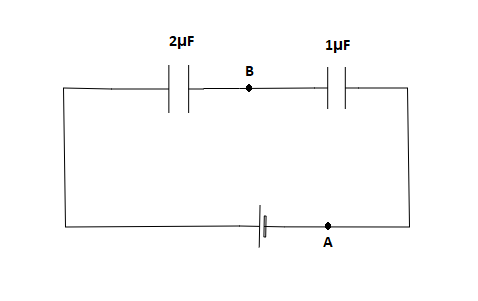Question
Question: The potential of \(A\) is \(10\;V\), then the potential of \(B\) is: 
(A) 325V
(B) 350V
(C) 3100V
(D) 50V
Solution
Here we have a circuit with three capacitors having capacitance 1μF each. The potential at a particular point is given and we have to find the potential at another point. For that, we have to find whether the capacitors are in series or parallel combination and using equivalent circuits we have to find the potential.
Complete Step by step solution:
Here we have three capacitors of 1μF each. Let us consider the equivalent circuit as shown below

We can see that two of the capacitors are connected in parallel and we can write the equivalent capacitance of these two capacitors as,
C1=1μF+1μF=2μF
The third capacitor is in series connection with the two capacitors that are in parallel. Now the equivalent circuit is as shown below,

The potential across a capacitor is given by,
V=CQ
where Q stands for the charge stored in the capacitor and C stands for the capacitance of the capacitor.
From this, we can write,
Q=VC
In a series combination, each capacitor carries the same amount of charge.
Since the two capacitors are in series connection the total capacitance can be written as,
C1=C11+C21
The capacitance C1=2μF and C2=1μF
Putting these values in the above equation, we get
C1=21+11=23
The capacitance, C=32
The potential at A, V=10V
Now the charge can be written as,
Q=32×10=320μC
The voltage across the 1μF capacitor can be written as,
VB−VA=320
where VB is the potential at the point B and VA is the potential at the point A.
Substituting VA=10V in the above equation we get
VB=320+10=350V
The answer is Option (B): 350V
Note: A series combination is employed to decrease the effective capacitance. The effective capacitance will be lower than the lowest capacitance in the combination. The parallel combination is employed to increase the effective capacitance. The effective capacitance is higher than the highest value of capacitance in the combination.
